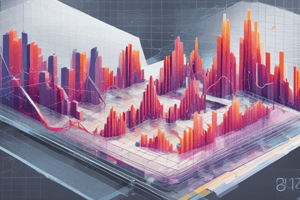Podcast
Questions and Answers
What is the recommended initial step when encountering a table problem during a test?
What is the recommended initial step when encountering a table problem during a test?
- Immediately start answering questions to save time.
- Scan the table to understand headings and basic data trends. (correct)
- Carefully read all the questions related to the table first.
- Attempt to recall similar tables from previous studies.
Why is it suggested to verify the concepts presented in a data table?
Why is it suggested to verify the concepts presented in a data table?
- To impress the examiner with prior knowledge.
- To confirm understanding of the biological principles underlying the data. (correct)
- To ensure the table aligns with previously memorized data.
- To identify potential errors in the table's construction.
What is the primary benefit of attempting to answer questions about a chart before looking at the provided options?
What is the primary benefit of attempting to answer questions about a chart before looking at the provided options?
- It allows for checking if the question is answerable with the given chart.
- It guarantees finding the correct answer quickly.
- It encourages critical thinking and reduces distraction from potentially misleading choices. (correct)
- It prevents wasting time on reading irrelevant options.
When analyzing a line graph, what does 'orienting yourself to the axes' primarily involve?
When analyzing a line graph, what does 'orienting yourself to the axes' primarily involve?
According to the recommendations, what approach should be adopted when facing complex chart problems on an exam?
According to the recommendations, what approach should be adopted when facing complex chart problems on an exam?
What is the significance of understanding the 'headings and units' in a chart or table?
What is the significance of understanding the 'headings and units' in a chart or table?
Identifying 'trends' in a chart primarily involves understanding:
Identifying 'trends' in a chart primarily involves understanding:
Which of the following is LEAST likely to be a recommended strategy for solving table or chart problems?
Which of the following is LEAST likely to be a recommended strategy for solving table or chart problems?
What is the intended outcome of following the recommended rules for solving table and chart problems?
What is the intended outcome of following the recommended rules for solving table and chart problems?
Complex table and chart problems are:
Complex table and chart problems are:
Flashcards
Table Orientation
Table Orientation
Scanning the table headings and identifying general trends in the data before reading questions.
Concept Verification
Concept Verification
Understanding the concepts behind the table data and relating them to biological principles.
Independent Question Answering
Independent Question Answering
Trying to answer a question based on your own analysis before looking at the answer choices.
Study Notes
Solving Table and Chart Problems Effectively
- Initial Scan: Before engaging with questions, thoroughly scan the table or chart. Understanding column headings and overall data trends is crucial.
- Data Verification: Verify the data's coherence with underlying concepts. Connect data to relevant biological or scientific principles.
- Independent Question Answering: When presented with a question, attempt to answer it independently prior to evaluating provided answer choices. This approach fosters critical thinking and avoids distraction from potential answer options.
- Chart Comprehension: For charts, thoroughly orient yourself with the x- and y-axes, including labels and units of measure. Understanding these elements provides essential context.
- Trend Identification: Identify and analyze trends within the data presented in line graphs or other chart types. Understanding the direction and shapes of lines is integral to data interpretation.
- Time Management: Allocate adequate time to these problems. Systematic evaluation, critical thinking, and thorough data analysis typically results in problem resolution.
- Avoid Panic: Complex problems may appear daunting; recognizing and following these steps minimizes difficulty, and makes problems seem less intimidating.
Studying That Suits You
Use AI to generate personalized quizzes and flashcards to suit your learning preferences.




